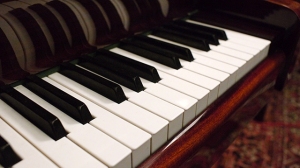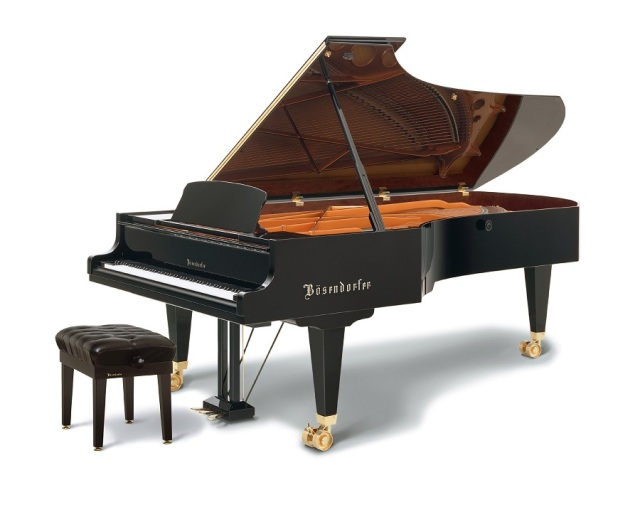The Joys of the Grand Piano
[Perfection of Art and Science]
by Andrew G. Lockhart

I have two confessions to make: I love pianos, most pianos; I hate digital keyboards. When mankind has spent three centuries designing and building a product that is, at once, delightful to look at, a joy to play and a pleasure to listen to, it seems to me a retrograde step to design and build a substitute which is none of these things.
Of course, to every rule – to every prejudice, there are exceptions. Some acoustic pianos are beyond the pale. Sat in a damp village hall or cold stone church for five decades or longer and brought out once a week for Sunday School or, more likely, for ‘special’ concerts, an instrument is, unlike a good wine, hardly going to improve with age. Alone, untuned and unplayed, it will surely develop faults if not suicidal tendencies!
My prejudice – if that is what it is – is not based upon a hatred of digital instruments per se. A number of manufacturers, notably the Japanese firm Yamaha, have managed to produce, using digital technology, pianos that approximate in both appearance and sound to the real thing. The works are contained in pieces of furniture one would be happy to display in one’s home.
When I speak of digital keyboards, I mean something else entirely – the short, squat box of circuits that sits unsteadily on a flimsy stand and has a single pedal which has to be taped to the floor to prevent it shooting off in all directions to the embarrassment and dismay of the pianist. Invariably, the sound emanates from a set of speakers, placed at a distance, rather than from the body of the ‘instrument.’ Any control that the pianist over touch and volume is countered by his (or her) inability to hear properly the sounds which pressure on the keys generate.
For more than thirty years of my life, I was an amateur and semi-professional pianist and accompanist. I have played on dozens, if not hundreds of pianos, from the sublime 97-key Bösendorfer grand on a stage in Germany to the grotesque upright, an octave of keys missing and the remainder tuned two tones below concert pitch! However, faced with a digital keyboard, my stomach turns over and my fingers tremble with anxiety.
If you share my passion – and my prejudice, there should be much in the next few paragraphs to enjoy. If you are a devotee of the digital keyboard, I hope to convince you what you are missing.
The modern grand piano is a work of art. From the powerful sonority of its bass strings to the delicate tinkle of its treble, it has the capacity to thrill and inspire as well as entertain. The sweeping curves and polished wood of its casing, the perfectly contrasting black and white of its eighty-eight keys, make it a highly desirable item of furniture in any home large enough to accommodate it. Its raised lid, the flügel that gives it its German name, suspended precariously over its internal organs, and reflecting their structure in its mirror surface, presides over the concert hall like Zeus at the council of Olympus.
No other instrument commands such a presence. Yet its role is as much to blend and complement as to dominate. It can play the Thunderer, compelling its lesser subjects to silence, but is equally at home as Orpheus, its gentle song transporting the listener to realms of delight. In the right hands, it can sing more sweetly than any human voice.
No other single instrument, excepting the organ and the harp, can produce such a range of sound. A trained singer can probably manage two octaves in comfort. Most acoustic instruments have a compass of about three or four; only by acting together as families, such as woodwinds or strings, can they hope to match the eight octave span of a modern Steinway or Bösendorfer.

The grand piano is also a triumph of science. Though stringed keyboard instruments already existed by the fifteenth century, it is only in the last three hundred years that the pianoforte, as we know it, has evolved. From humble beginnings, it has developed into the miracle, the very pinnacle of mechanical and acoustic engineering we know today.
A modern grand has over ten thousand components. Its action is a finely balanced arrangement of levers, rollers and springs, tolerant of the full power of the virtuoso’s arm yet sensitive to the lightest touch of a child’s finger. Its soundboard is machined with precision while its cast-iron frame can support a tension of twenty-five tonnes or more.
The strings are manufactured to fine tolerances and are set to vibrate at precise frequencies and wavelengths when struck, which lends the piano its unique properties. One has only to listen to a piano gone slightly out of tune to appreciate how sensitive these settings are, and how critical to good performance is the work of the professional tuner.
We are all familiar with the instrument, be it a nine-foot model on the concert platform or a modest ‘baby’ grand in the salon. But, whether as musician, student or simple music lover, do we not take it for granted? Like television or the car, it is something that has always been around. The six-year-old sitting at his scales is unlikely to give much thought to the workings of the diabolical machine he is being encouraged to play; the concert-goer is concerned with the melodic nature of a piece of music and has probably little interest in the numbers of vibrations per second of each of the piano strings.
Yet the grand piano is much more than an instrument of torture for the novice pianist; it is much more than a sequence of pleasant harmonies wafting across the concert hall or through the speakers of a CD player. It is the sum total of the three hundred and more years of history – a history of triumph and failure, of the genius of composers who have written its music, of the brilliance of virtuosos who have played it, of the perseverance of artists and engineers who have designed and built it.
The grand piano is the perfect fusion of art and science. In black and white!
*****
PS I’ll be going back to talking about books soon!

Lovely post. They are things of beauty but not great for getting up two sets of stairs for a gig. Or for staying in tune -take the upright in my living room for example! 🙂
LikeLike
Make sure your gigs are on the ground floor, Karen! As for the one in your living room, I can recommend a good tuner. 🙂
LikeLike